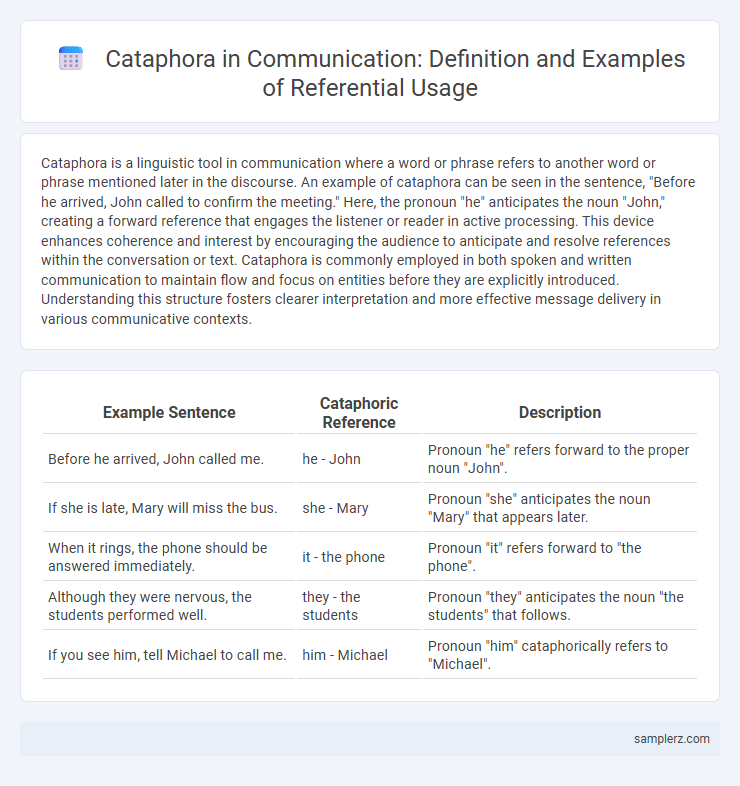Cataphora is a linguistic tool in communication where a word or phrase refers to another word or phrase mentioned later in the discourse. An example of cataphora can be seen in the sentence, "Before he arrived, John called to confirm the meeting." Here, the pronoun "he" anticipates the noun "John," creating a forward reference that engages the listener or reader in active processing. This device enhances coherence and interest by encouraging the audience to anticipate and resolve references within the conversation or text. Cataphora is commonly employed in both spoken and written communication to maintain flow and focus on entities before they are explicitly introduced. Understanding this structure fosters clearer interpretation and more effective message delivery in various communicative contexts.
Table of Comparison
| Example Sentence | Cataphoric Reference | Description |
|---|---|---|
| Before he arrived, John called me. | he - John | Pronoun "he" refers forward to the proper noun "John". |
| If she is late, Mary will miss the bus. | she - Mary | Pronoun "she" anticipates the noun "Mary" that appears later. |
| When it rings, the phone should be answered immediately. | it - the phone | Pronoun "it" refers forward to "the phone". |
| Although they were nervous, the students performed well. | they - the students | Pronoun "they" anticipates the noun "the students" that follows. |
| If you see him, tell Michael to call me. | him - Michael | Pronoun "him" cataphorically refers to "Michael". |
Understanding Cataphora in Communication
Cataphora in communication occurs when a pronoun or a word refers forward to another word or phrase mentioned later in the sentence, as in "Before he spoke, John cleared his throat." This linguistic device enhances coherence by creating suspense or emphasis, guiding the listener or reader to anticipate the forthcoming information. Understanding cataphora is crucial for grasping the flow of discourse and improving clarity in both written and spoken communication.
Definition and Importance of Cataphoric Reference
Cataphoric reference occurs when a pronoun or other linguistic unit refers forward to another element that appears later in the text, enhancing coherence by creating anticipation. This forward-looking approach allows speakers or writers to maintain interest and guide listeners or readers toward important information, reinforcing effective communication. Understanding cataphoric reference is crucial for analyzing discourse structure and improving language comprehension across different communication contexts.
Common Structures Featuring Cataphora
Cataphora commonly appears in sentences where a pronoun precedes its referent, such as in "Before he entered, John paused." Typical structures include demonstratives like "this" or "that" anticipating a following noun or phrase, for example, "This is what she wanted." These patterns enhance textual cohesion by linking elements forward, guiding readers through the discourse efficiently.
Classic Examples of Cataphora in English
Classic examples of cataphora in English include sentences where a pronoun precedes its referent, such as "Before he arrived, John called his office." Another well-known example is "If she wants to win, Mary must practice daily," where "she" anticipates "Mary." These structures enhance coherence by linking forward to subsequent information within the discourse.
Cataphora vs. Anaphora: Key Differences
Cataphora occurs when a pronoun or other reference word points forward to a later word or phrase, as in "Before she arrived, Mary called." Anaphora, in contrast, refers backward to something previously mentioned, such as, "Mary called before she arrived." Understanding the key differences between cataphora and anaphora clarifies how speakers manage temporal and referential coherence in communication.
Cataphoric Reference in Everyday Speech
Cataphoric reference in everyday speech occurs when a pronoun or phrase points forward to a word or phrase that appears later in the sentence, such as "Before he arrived, John called me." This linguistic device enhances cohesion by creating anticipation and guiding listeners to upcoming information. This structure is prevalent in natural conversation and storytelling, aiding listeners in processing information efficiently.
Cataphora in Written Discourse
Cataphora in written discourse occurs when a pronoun or other linguistic unit refers forward to a later noun or phrase, creating anticipation and cohesion within the text. An example is the sentence, "Before she arrived, Mary had already prepared the room," where "she" points forward to "Mary." This forward reference enhances readability by linking elements across sentences and maintaining the reader's engagement.
Ambiguity and Clarity in Cataphoric References
Cataphora occurs when a pronoun or other linguistic unit refers forward to another word or phrase that appears later in the sentence or discourse, such as "Before she arrived, Lisa called." This structure can create ambiguity if the referent is not immediately clear, potentially confusing the listener or reader. Clear cataphoric references require well-defined antecedents within the context to ensure precise communication and avoid misinterpretation.
Enhancing Cohesion through Cataphora
Cataphora enhances cohesion by using pronouns or terms that refer forward to a later word or phrase, such as in the sentence, "Before he arrived, John called." This technique creates anticipation and links parts of the text more tightly, improving flow and readability. Employing cataphora strategically strengthens textual coherence and guides the reader through connected ideas smoothly.
Practical Exercises for Using Cataphora
Practical exercises for using cataphora often involve sentences where the pronoun precedes the noun it refers to, such as "Before he entered the room, John checked his phone." These exercises enhance understanding of forward reference by encouraging learners to identify and create sentences with anticipated referents. Mastering cataphora improves coherence in complex sentence structures and advanced communication skills.

example of cataphora in reference Infographic
 samplerz.com
samplerz.com